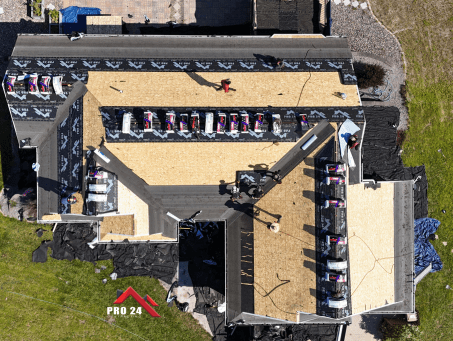When it’s time to replace or repair a roof, one of the first questions homeowners ask is: “How much will this cost?” This is where a roof cost estimator comes in. Roof cost estimators provide a breakdown of expected expenses, giving homeowners a clear picture of the investment they’ll need to make.
But how do these estimators work, and what factors influence their results? In this article, we’ll dive into the key considerations that affect a roof cost estimator’s results, from roof size and materials to labor costs and regional differences.
1. Roof Size and Complexity
The size of your roof is one of the most significant factors in determining the calculations of a roof cost estimator. Roof size is typically measured in “squares,” with one square representing 100 square feet. Naturally, the larger the roof, the more materials are required, from shingles and underlayment to flashing and fasteners. Larger roofs also demand additional labor to install, further increasing the overall cost of your roofing project.
However, size is just one piece of the puzzle when it comes to estimating roof costs. The complexity of your roof design is equally important. A straightforward gable roof with minimal slopes and clean lines is far less expensive to install than a complex roof with multiple pitches, dormers, valleys, or other architectural features.
Intricate designs not only require more materials—such as extra flashing for valleys and seals for dormers—but also demand specialized skills and tools. Roofers may need to spend more time ensuring precise cuts and secure fits, especially in hard-to-reach areas, which drives up labor costs.
Complex roofs may also necessitate additional safety measures or equipment, such as scaffolding or harnesses, to accommodate steep pitches or unique designs. These additional considerations further add to the project’s expense.
In summary, while roof size is a major determinant of cost, the complexity of your roof’s design can significantly influence the final price, making it essential to consider both when planning a roofing project.
2. Roofing Materials
The choice of roofing materials greatly impacts the estimate. From affordable asphalt shingles to high-end metal or slate options, materials vary widely in price, durability, and aesthetic appeal.
- Asphalt Shingles. The most common and budget-friendly option, costing $100–$400 per square.
- Metal Roofing. Durable and energy-efficient, but typically costs $300–$900 per square.
- Clay or Concrete Tiles. Stylish but heavy, with costs ranging from $500–$1,000 per square.
- Slate Roofing. A premium material known for longevity, costing $1,000–$2,000 per square.
Additionally, homeowners may choose upgraded materials like architectural shingles or coatings for added weather resistance, which can increase the total cost.
3. Labor Costs
Labor expenses play a critical role in determining a roof cost estimator’s calculations, often representing a significant portion of the overall cost. Roofing is a labor-intensive process that demands highly skilled workers capable of handling materials, tools, and safety precautions with precision and efficiency.
These professionals must be trained to navigate steep pitches, manage heavy equipment, and ensure that each installation meets industry standards for durability and performance.
The complexity of the job directly impacts labor costs. A straightforward roof replacement on a simple gable design will typically require less time and effort than working on a multi-pitched or uniquely shaped roof with dormers, skylights, or valleys.
Additionally, labor costs rise significantly if the project involves removing an old roof or addressing structural issues such as rotten decking, water damage, or insufficient support beams. Tasks like these add layers of complexity, requiring more time, effort, and expertise to complete correctly.
Local market conditions also play a vital role in labor cost variability. In areas with higher living expenses, roofing companies often charge more to account for increased wages and operational costs.
Conversely, regions with lower costs of living may offer reduced labor rates, though the availability of skilled workers could impact both the quality of work and project timelines.
Beyond regional factors, the season and demand for roofing services can also influence labor expenses. Roofing work tends to peak during warmer months or after severe weather events, leading to higher rates due to increased demand for qualified roofers.
On the other hand, scheduling work during slower seasons might yield more competitive pricing.
Ultimately, labor costs reflect the expertise, effort, and time required to ensure your roof is installed or repaired properly. These expenses are not just a line item in your estimate but an investment in the long-term performance and safety of your roof.
4. Roof Pitch and Accessibility
The pitch—or steepness—of your roof is another critical factor that significantly impacts the cost of a roofing project. Steep roofs present unique challenges that require more effort, time, and resources to address safely and effectively. Roofs with a high pitch are inherently more difficult to navigate, as workers must maintain their balance on sharp inclines while handling tools, materials, and equipment.
To mitigate safety risks, additional precautions are necessary, such as the use of harnesses, specialized footwear, and protective gear. In some cases, scaffolding or lift systems may be required to provide secure access to the work area, which increases the cost of labor.
Compared to flat or low-slope roofs, steep roofs demand greater expertise, extra time, and higher labor costs, as workers must proceed with care to ensure both their safety and the quality of the installation.
Accessibility is another important element that influences your roofing estimate. Homes with tight spaces, intricate landscaping, or other physical barriers can make it more challenging for crews to transport materials and set up equipment.
For instance, if large trees, fences, or narrow driveways block easy access to the roof, roofing companies may need to deploy cranes, boom lifts, or additional scaffolding to navigate these obstacles. Each piece of equipment adds to the project’s expense—not only for the rental or operational cost but also for the additional labor required to set up and operate it.
Additionally, hard-to-reach roofs, such as those on tall homes or buildings with unusual architectural features, further complicate the process. Roofers may need to spend extra time carefully maneuvering around these obstacles, which slows down the work and increases labor costs.
Even factors like the location of material staging areas, such as where shingles, nails, and underlayment are stored during the project, can impact efficiency. If workers must transport materials over long distances or up multiple flights of stairs, it increases the time and effort required, ultimately affecting the bottom line.
5. Underlayment and Insulation
Beyond the visible surface materials, a roof cost estimator also accounts for components like underlayment and insulation.
- Underlayment. The protective layer beneath the shingles, typically made of felt or synthetic materials, impacts the cost.
- Insulation. If your roof requires new insulation, this will increase the overall estimate, especially if your attic needs upgrades to meet energy efficiency standards.
These components are critical for ensuring the roof’s longevity and performance, so skimping on them could lead to higher maintenance costs later.
6. Roof Removal and Disposal
Replacing a roof often involves removing the old one. The cost of tearing off and disposing of old materials depends on the type and volume of debris. For example:
- Asphalt shingles are relatively inexpensive to remove, costing $1–$3 per square foot.
- Heavier materials like slate or clay tiles require more labor and equipment, raising removal costs.
- Disposal fees can also vary based on local landfill rates.
Homeowners should factor this into their budget when requesting an estimate.
7. Permits and Inspections
In many areas, roofing projects require permits and inspections to ensure compliance with building codes. Permit fees vary depending on the scope of work and location, and they’re typically included in a roof cost estimator’s breakdown.
After the roof is installed, inspections may be required to verify proper installation. These inspections ensure your roof meets safety and durability standards, but they can also add to the total project cost.
8. Warranties and Additional Features
Homeowners seeking long-term peace of mind may opt for extended warranties or additional features, which can increase the estimate.
- Extended Warranties: Cover repairs or replacements beyond the standard manufacturer’s warranty.
- Upgraded Features: Such as impact-resistant shingles, solar panels, or skylights, will add to the total cost.
While these options require a higher upfront investment, they can save money in the long run by reducing maintenance and energy expenses.
9. Seasonal Pricing
Timing can also affect a roof cost estimator’s results. Roofing is often in higher demand during certain seasons, such as spring and summer, leading to increased labor and material costs. Scheduling your project during slower periods, like winter, might save money.
10. How Homeowners Can Get an Accurate Estimate
To ensure an accurate estimate, homeowners should:
- Provide Accurate Measurements. Share as much information as possible about your roof’s size and design.
- Be Clear About Preferences. Specify your desired materials and features upfront.
- Research Local Costs: Compare multiple estimates to understand regional pricing trends.
- Account for Contingencies. Set aside a buffer for unexpected repairs or upgrades.
A trusted roofing contractor like Pro 24 can provide detailed estimates tailored to your home’s unique needs.
Final Words
A roof cost estimator takes into account various factors to deliver a comprehensive and accurate estimate. From the size and complexity of your roof to materials, labor, and regional considerations, every detail matters. By understanding these factors, homeowners can better plan for their roofing projects and make informed decisions.
At Pro 24 Contracting, we’re committed to helping you navigate the roofing process with confidence. Whether you’re repairing damage or installing a brand-new roof, we’ll provide an estimate that reflects your home’s needs and your budget. Contact us today!

